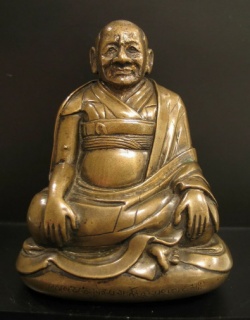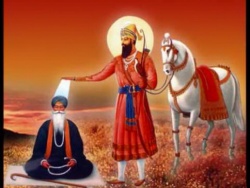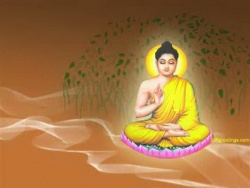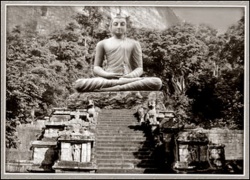Go Lotsāwa Zhonnu Pel
Zhonnu Pel ('gos lo tsA ba gzhon nu dpal) was born in a small town called Drongnak Megu (grong nag me dgu) in Chonggye region ('phyongs rgyas) of Southern Tibet in 1392, the water-monkey year in the seventh sexagenary cycle. His father was called Goton Jungne Dorje ('gos ston 'byung gnas rdo rje) and his mother was named Sitar Kyi (srid thar skyid). 'Go' ('gos) was the name of their family; Zhonnu Pel was the third child among their eight children.
Zhonnu Pel was an intelligent child and he easily learned reading and memorized some lengthy texts by the age of nine. Beginning his education at Chengye Lhakhang (spyan g.yas lha khang), he received the initial monastic vows (rab byung) from Chenye Khenpo Sanggye Pelwa (spyan g.yas mkhan po sangs rgyas dpal ba, d.u.) and received teachings on texts such as the Bodhisattvacharyāvatāra from Lobpon Sherab Dargye (slob dpon shes rab dar rgyas, d.u.).
Beginning in 1403, at the age of twelve, Zhonnu Pel studied traditional Buddhist subjects such as the Pramāṇavārtika under the tutorship of Tsetang Samten Zangpo (rtse thang mkhan po bsam gtan bzang po, d.u.); Prajñāpāramitā under Lachen Shakya Gyelpo (bla chen shAkya rgyal po, 1384-1474); Madhyamaka under Yeshe Gyeltsen ('phan po thang sag mkhas pa e shes rgyal mtshan d.u.); and Vinaya and Abhidharma under Kyomorlung Geshe Tendzin Dondrub (skyor mo lung dge bshes bstan 'dzin don grub, d.u.).
He then studied under the Fifth Karmapa, Dezhin Shekpa (karma pa 05 de bzhin gshegs pa, 1384-1415) from whom he initially received the bodhicitta vows. Later the Karmapa gave him teachings on the Six Yogas of Nāropa and other teachings.
Zhonnu Pel received teachings from some sixty lamas from multiple traditions. He received teachings on Lamrim, the Six Yogas of Nāropa, and other topics from Tsongkhapa Lobzang Drakpa (tsong kha pa blo bzang grags pa, 1357-1419).
He received Nyingma teachings from Tanak Choje Dolmawa (rta nag chos rje sgol ma ba, d.u.) and Gotruk Repa (rgod phrug ras pa, d.u.). His Sakya teachers included Sheja Kunrik Shakya Gyeltsen (shes bya kun rig shAkya rgyal mtshan 1367-1449) and Nartang Lotsāwa Sangha Shri (snar thang lo tsA ba sang+g+ha shrI, d.u.), with whom he studied Sanskrit. Other prominent teachers included Marton Gyeltsen Ozer (dmar ston rgyal mtshan 'od zer, d.u.), the fourteenth Nartang Khenchen Drupa Sherab (snar thang mkhan chen 14 grub pa shes rab, 1357-1423), the Second Zhamar, Khachod Wangpo (zhwa dmar 02 mkha' spyod dbang po, 1350-1405), Dzepa Pelden Zangpo (mdzes pa dpal ldan bzang po, d.u.), Sanggye Rinchen (sangs rgyas rin chen, 1339-1424), and Ngok Jangchub Pel (rngog byang chub dpal d.u.).
Zhonnu Pel served as a translator for the Indian Paṇḍit Vanaratna, known in Tibetan as Paṇchen Nakyi Rinchen (ba na rat+na; pan chen nags kyi rin chen, 1384-1468), when he visited and toured Tibet, thus earning the title Lotsāwa, or translator.
Until the age of fifty Zhonnu Pel spent most of his time studying, and only then began teaching and composing works. Among his important disciples were the Seventh Karmapa, Chodrak Gyatso (karma pa 07 chos grags rgya mtsho, 1454-1506); the Fourth Zhamar, Chodrak Yeshe (zhwa dmar 04 chos grags ye shes, 1453-1524); Trimkhang Lotsāwa Sonam Gyatso (khrims khang lo tsA ba bsod nams rgya mtsho, 1424-1482); Minyakpa Dorje Sengge (mi nyag pa rdo rje seng+ge, b.1462); the Second Drukchen, Kunga Peljor ('brug chen 02 kun dga' dpal 'byor, 1428-1476); and Dzongchungpa Jampa Dorje Gyeltsen (rdzong chung pa byams pa rdo rje rgyal mtshan, 1424-1498).
He was an important master in the transmission of several teachings including the Nyingma Dorje Zampa (rnying ma rdo rje zam pa).
He composed a large number of treatises that he began only after the age of seventy. Some of the titles include The Extremely Clear Gem; a Commentary of the Essential Meaning of the Kālacakra Tantra (dpal dus kyi 'khor lo'i rgyud kyi dka' 'grel snying po'i don rab tu gsal ba'i rgyan), written in 1467;
Commentary on Mahāyānottaratantra Śāstra (theg pa chen po rgyud bla ma'i bstan bcos), Commentary on Abhisamayālaṅkāra; and a large commentary on the Ratnagotravibhāga that was completed in 1473 and printed in 1479. Ten volumes of works were said to have been completed, but few are extant.
Go Lotsāwa is perhaps best known for this massive history of Buddhism in Tibet, The Blue Annals (deb ther sngon po) that he started in 1476 at the age of eighty-four, dictating to attendants, and completed in 1478. It includes vital information about early Tibetan history and religious lineages. Go Lotsāwa drew from earlier works such as The Red Annals, written in 1346 by Tselpa Situ Kunga Dorje (tshal pa si tu kun dga' rdo rje, 1309-1364), and Buton Rinchen Drub's (bu ston rin chen grub, 1290-1364) History of Buddhism, and also many other earlier historical records. The work was originally preserved and curved into wooden-blocks in Yangpachen (yangs pa chen) near Lhasa but later transferred to Kundeling (kun bde glin) in Lhasa. A wooden-block was also curved in Ganden Chokhorling in Amdo (a mdo dga' ldan chos ’khor gling).
Go Lotsāwa Zhonnu Pel passed into nirvana at the age of ninety in 1481, the iron-ox year of the eighth sexagenary cycle.
Sources
Bsod nams grags pa . 2007. Yid bzang rtse ba. In Bka' gdams gsar rnying gi chos 'byung yid kyi mdzes rgyan, pp. 212-213. Rnga yul kirti dgon dge ldan legs bshad gling. TBRC W1KG4257.
Bstan 'dzin lung rtogs nyi ma. 2004. 'Gos lo gzhon nu dpal. In Snga 'gyur rdzogs chen chos 'byung chen mo, pp. 194-195. Beijing: Krung go'i bod rig pa dpe skrun khang. TBRC W27401.
Don rdor and Bstan 'dzin chos grags. 1993. Gangs ljongs lo rgyus thog gi grags can mi sna. Lhasa: Bod ljongs mi dmangs dpe skrun khang, pp. 492-494.
Khetsun Sangpo. 1973. Biographical Dictionary of Tibet and Tibetan Buddhism. Dharamsala: LTWA, vol. 3, p. 568.
Mi nyag mgon po et. al. 1996. 'Gos lo gzhon nu dpal gyi rnam thar mdor bsdus. In Gangs can mkhas dbang rim byon gyi rnam thar mdor bsdus, vol. 1, pp. 174-179. Beijing: Krung go'i bod kyi shes rig dpe skrun khang. TBRC W25268.
Si tu pan chen 08 chos kyi 'byung gnas. 1990. 'Gos lo tsA ba gzhon nu dpal. In The Collected works of the great ta'i si-tu-pa kun-mkhyen chos-kyi-'byun-gnas-bstan-pa'i-nin-byed, pp. 731-732. Sansal: Pelpung sungrab nyamso khang.
Si tu pan chen 08 chos kyi 'byung gnas and Be lo Tshe dbang kun khyab. 1972. 'Gos lo tsA ba gzhon nu dpal. In Sgrub brgyud karma kaM tshang brgyud pa rin po che'i rnam par thar pa rab byams nor bu zla ba chu shel gyi phreng ba, vol. 1, pp. 644-645. New Delhi: D. Gyaltshan & Kesang Legshay. TBRC W23435.
Skyes mchog pa smon lam dpal. Mkhan po rin po che thams cad mkhyen pa gzhon nu'i zhal snga nas kyi rnam par thar pa. TBRC W26618
Zhwa dmar IV Chos grags ye shes. 2004 (1517). Dpal ldan bla ma dam pa mkhan chen thams cad mkhyen pa don gyi slad du mtshan nas smos te gzhon nu dpal gyi rnam par thar pa yon tan rin po che mchog tu rgyas pa'i ljon pa. Beijing: Mi rigs dpe skrun khang.
Zhwa dmar IV Chos grags ye shes. 2009. Dpal ldan bla ma dam pa mkhan chen thams cad mkhyen pa don gyi slad du mtshan nas smos te gzhon nu dpal gyi rnam par thar pa yon tan rin po che mchog tu dgyes pa'i ljon pa. In Gsung 'bum chos grags ye shes, vol. 1, pp. 483-588. Beijing: Krung go'i bod rig pa dpe skrun khang. TBRC W1KG4876.
Samten Chhosphel July 2011



